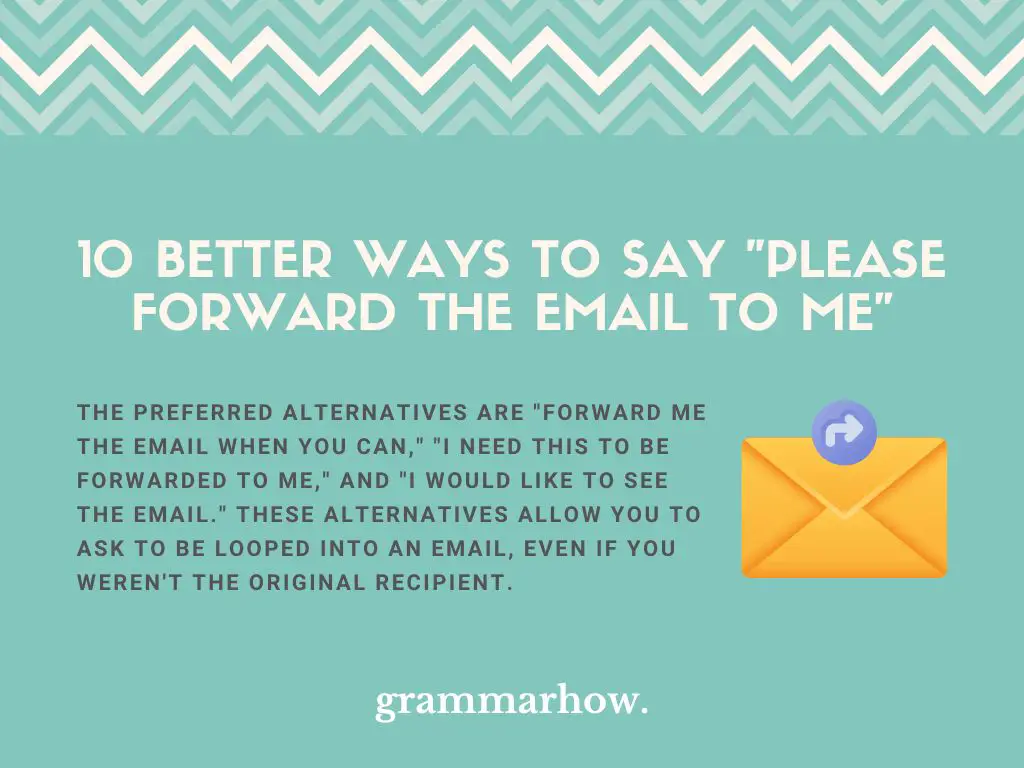Have you wondered how to ask someone to forward an email before? Well, you’re in luck. This article was put together to answer that question. We’ll explore the best ways to say, “please forward the email to me” when you want to be kept in the loop about something.
The preferred alternatives are “forward me the email when you can,” “I need this to be forwarded to me,” and “I would like to see the email.” These alternatives allow you to ask to be looped into an email, even if you weren’t the original recipient.

Forward Me The Email When You Can
“Forward me the email when you can” is a good way to ask to have an email forwarded. “When you can” shows that you respect that someone might be busy and have things to do.
As long as you eventually get forwarded the email, this phrase works well.
- Forward me the email when you can. I would like to be included in the chain to ensure everything goes smoothly.
- Forward me the email when you can, Martin. I need to see what they’re talking about, and I know I can trust you on this.
- What email? Forward me that email when you can. I need to find out what’s being said before it gets out of hand.
I Need This To Be Forwarded To Me
“I need this to be forwarded to me” is a good synonym that shows you want to be kept in the loop about something. If you want something to get “forwarded” to you by someone else, you can use this phrase to ask for it.
It’s written in the passive voice, which means it’s not the most confident phrase you can use. Still, it works well in many formal situations to ask for a forward.
- I need this to be forwarded to me. I am in charge here, so I need to know what happens to my team when they have these issues.
- I need this to be forwarded to me. Would you please go to your inbox and send it to me as soon as you return to your desk?
- Look, I need this to be forwarded to me. I can’t be kept out of the loop on things like this. I need to be in control here.
I Would Like To See The Email
“I would like to see the email” is a great alternative. It does not implicitly ask someone to “forward” an email. Instead, it asks that they “show” you the email, which usually implies that you’d like to have it forwarded to your inbox.
- I would like to see the email you’re referring to. When you get a minute, please forward it to me so I can see what you’re talking about.
- I would like to see the email to work out whether this is a serious matter. Make sure you forward it to me as soon as you’re able.
- I would like to see the email. I think it would be good for you to get a second opinion about it from me.
Forward The Email To Me
“Forward the email to me” is a commanding alternative you can use. It shows that you would like to read an email that has been sent to someone else. You don’t have to use words like “please” if you do not feel they are useful.
If you want to come across as confident and in control, avoiding “please” sometimes helps with that.
- Forward the email to me. That’s an order. I don’t want to have to ask again, so you better go and get it done now.
- Forward the email to me so that I can take a look. I’ll be able to see whether it’s an important one that must be followed up.
- Forward the email to me. I’m not sure about the answer yet. I’ll look into it and reply to them when I know more.
Can You Share The Email With Me?
“Can you share the email with me?” is a good question you can ask. Rather than expecting someone to forward an email or ordering them to do so, you can ask this question to make sure they’re comfortable with sending the email to you.
If they believe they’re not allowed to forward the email to you or would rather not, they can reject you. It’s okay to reply “yes” or “no” to this question because you do not expect anything from them.
- Can you share the email with me? I appreciate that I might be asking a lot, but I feel like I need to be included in this.
- Can you share the email with me? I want to see if what you’re saying is true. I need to know if there’s anything we can do.
- Can you share the email with me? Don’t worry. I won’t tell anyone that you’ve forwarded it to me. It will be our secret.
Can You Forward The Email To Me?
“Can you forward the email to me?” is a good question choice. You can use this to figure out whether someone is willing to send you the email. If not, they might want to turn down your question with a simple “no” or “I’m sorry, but I can’t.”
- Can you forward the email to me? I would like to know what’s being said. I think I can help figure out the situation for both parties.
- Can you forward the email to me? I’ll reply to them much better than you because I have more information about the situation.
- Can you forward the email to me? That will allow me to ask around and see what I can find out about whatever is happening here.
Are You Able To Forward The Email To Me?
“Are you able to forward the email to me?” is a great choice as far as questioning alternatives go. You can use it to ask whether someone is capable of forwarding the email to you or if someone has told them they’re not allowed to already.
- Are you able to forward the email to me? If not, don’t worry. I’ll figure something else out later in the day.
- Are you able to forward the email to me? I would like a physical copy of it, but I don’t appear to have a link to it yet.
- Are you able to forward the email to me? I can help, but I need to see what’s being said right now before taking this further.
You Should Forward This ASAP
“You should forward this ASAP” is a great alternative you can use. It works well because it demands that you get the email as soon as someone is able to send it.
You should use this phrase if you think you are entitled to receive the email. It shows that you expect to hear back from them and would like to be involved in the forwarding process.
- You should forward this ASAP. I’m not sure if this is something that you’re supposed to be talking about via email.
- I’m glad you came to me about this. You should forward this ASAP. I’ll see if there’s anything I can do on my end to fix things.
- You should forward this ASAP. There’s no reason for you to sit on this email without finding out what others might say.
I Would Like To Read The Email
“I would like to read the email” is a simple way to ask someone to forward it without using those words. Instead, “forwarding” is implied through context.
If you are not CC’d in an email, you might still want to read it. If you think it’s important that you know about it, use this phrase to try and get someone to forward the email to you.
- I would like to read the email. Can you please send it to me as well, so I can see whether this matter is important enough to escalate?
- That sounds very interesting. I would like to read the email. I believe some things need to be discussed about it.
- I would like to read the email. When you get a moment, please forward it to me. I think I’ll be able to crack the case.
Send It Across To Me, Please
“Send it across to me, please” is a more informal synonym. You can use this when you want someone to send you an email, but you don’t want to sound like an overbearing boss or anything like that.
If you simply want to request that someone should send you an email, you should use this phrase.
- Send it across to me, please. I will be able to take a closer look at it, and I should be able to get more information from the manager.
- Send it across to me, please. That way, I’ll be able to see what’s going on in your conversation. I’ll help you get to the bottom of it.
- Send it across to me, please. I should be looped in with things like this. There’s no reason for me to be kept outside of the discussion.

Martin holds a Master’s degree in Finance and International Business. He has six years of experience in professional communication with clients, executives, and colleagues. Furthermore, he has teaching experience from Aarhus University. Martin has been featured as an expert in communication and teaching on Forbes and Shopify. Read more about Martin here.
